The Global Shipping Report
January U.S. Container Import Volumes Up 7.9% from December Driven by Chinese Imports
In January 2024, U.S. container import volume increased 7.9% from December 2023—the largest month-over-month growth for January in the last seven years. A 14.9% rise in imports from China fueled the gains with the Ports of Los Angeles and Long Beach getting the lion’s share of it. The combination of the Panama drought and Middle East conflict is beginning to impact transit times as delays at the top East and Gulf Coast ports increased considerably. The February update of the logistics metrics Descartes is tracking shows accelerated container import volume amid signs that global supply chain performance could be impacted throughout 2024 because of conditions at the Panama and Suez Canals and upcoming labor negotiations.
In this Article...
- toc
U.S. container imports grow significantly.
January 2024 U.S. container import volumes increased 7.9% from December 2023 to 2,273,125 twenty-foot equivalent units (TEUs) (see Figure 1). Versus January 2023, TEU volume was higher by 9.9%, and up 9.6% from pre-pandemic January 2019.
Figure 1: U.S. Container Import Volume Year-over-Year Comparison
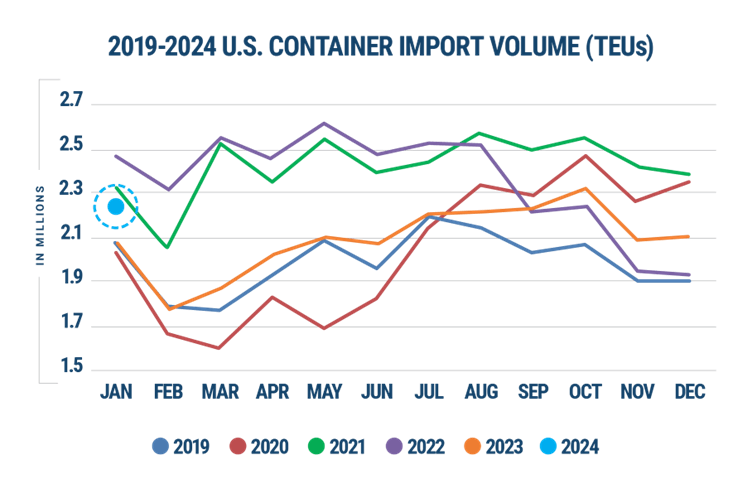
Source: Descartes Datamyne™
In the previous six years, comparing December to January, import volume varied from small declines to large increases; however, January 2024 import volume shows the highest month-over-month growth in the last seven years at 7.9% (see Figure 2).
Figure 2: December to January U.S. Container Import Volume Comparison

Source: Descartes Datamyne™
For the top 10 U.S. ports, container import volume in January 2024 was significantly up by 149,906 TEUs (8.4%) versus December 2023 (see Figure 3). The Port of Los Angeles (77,085 TEUs) and Long Beach (48,054 TEUs) experienced the greatest container volume increases from December, while the ports of Houston (-6,042 TEUs) and Charleston (-4,331 TEUs) had the greatest decreases.
Figure 3: December 2023 to January 2024 Comparison of Import Volumes at the Top 10 U.S. Ports

Source: Descartes Datamyne™
Chinese imports in January also significantly increased and were up by 14.9% over December 2023 to 905,173 TEUs, considerably closing the gap (now -9.8%) from the August 2022 high (see Figure 4). The top commodity codes (HS-2s) responsible include HS-94 (Furniture, Bedding, etc.), HS-39 (Plastics and Articles Thereof) and HS-84 (Nuclear Reactors, Boilers, Machinery, etc.). China represented 39.8% of the total U.S. container imports in December, an increase of 2.4% from December, but still down 1.7% from the high of 41.5% in February 2022 and, notably, the highest percentage of U.S. imports in two years.
Figure 4: January 2023 – January 2024 Comparison of U.S. Total and Chinese TEU Container Volume

Source: Descartes Datamyne
For the top 10 countries of origin (CoO), U.S. container import volume in January 2024 increased 9.6% (146,240 TEUs) from the previous month, with China having the greatest volume increase (117,084 TEUs) and Germany (-2,851 TEUs) having the largest volume decrease (see Figure 5).
Figure 5: December 2023 to January 2024 Comparison of U.S. Import Volumes from Top 10 Countries of Origin
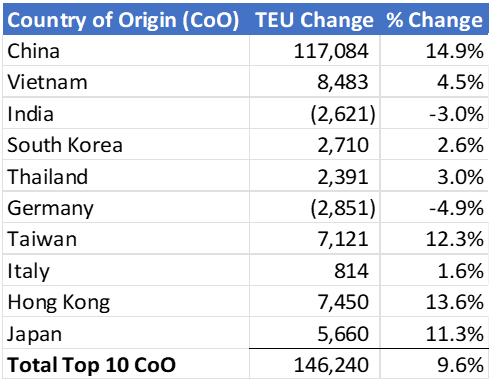
Source: Descartes Datamyne
Growth at the Ports of Los Angeles and Long Beach gives West Coast ports market share lead.
In January 2024, the volume share at top West Coast ports increased based upon the significant volume increase at the Ports of Los Angeles and Long Beach. Comparing the top five West Coast ports to the top five East and Gulf Coast ports in January 2024 versus December 2023 shows that, of the total import container volume, top West Coast ports increased to 43.0% (up 3.3%) and top East and Gulf Coast ports decreased to 42.4% (down 2.5%). Compared to smaller ports, the top 10 ports’ share in January 2024 increased to 85.4%, up slightly (0.9%) versus December 2023 (see Figure 6).
Figure 6: Volume Analysis for Top Ports, West Coast Ports and East and Gulf Coast Ports
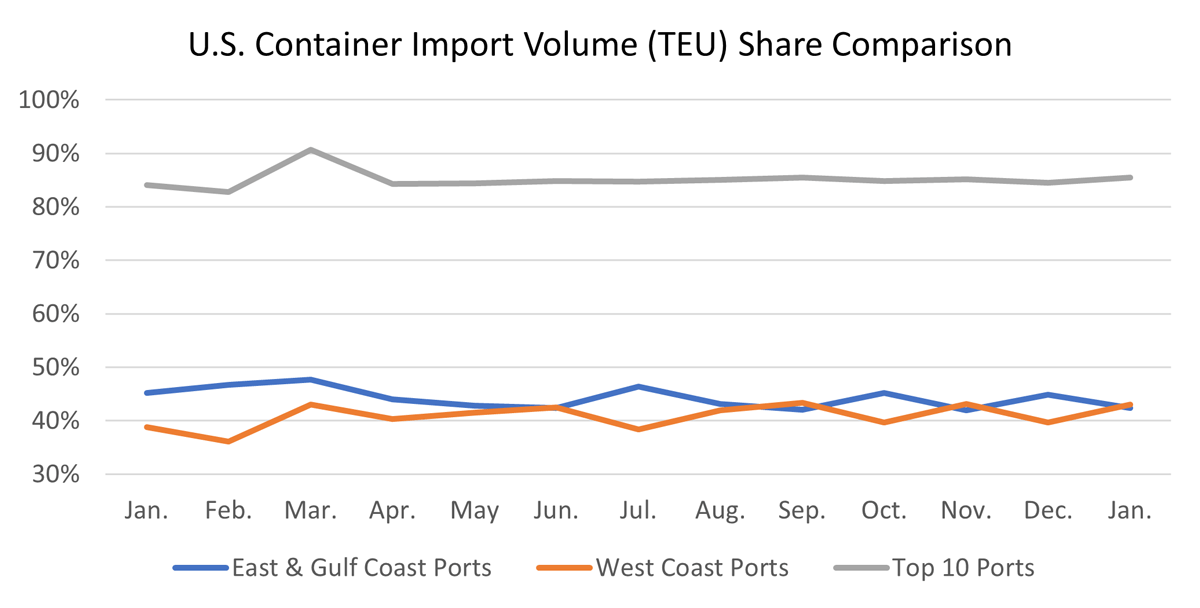
Source: Descartes Datamyne
January port transit delays increased overall, especially at East Coast ports.
Overall port transit delays in January 2024 increased across the top ports (see Figure 7), with the exception of the Port of Los Angeles, which showed a slight decrease. The top East Coast ports had significant increases with the Ports of Norfolk, New York/New Jersey and Charleston seeing 2+ day transit delay increases.
Figure 7: Monthly Average Transit Delays (in days) for the Top 10 Ports (Nov. 2023 – Jan 2024)
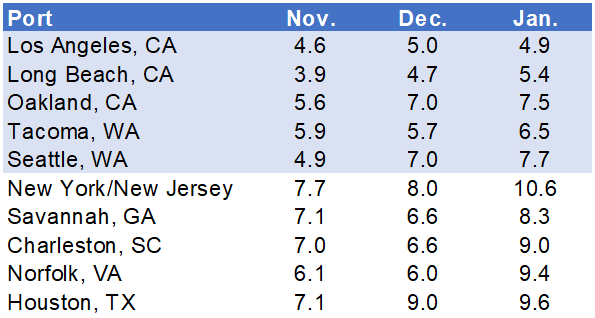
Source: Descartes Datamyne™
Note: Descartes’ definition of port transit delay is the difference as measured in days between the Estimated Arrival Date, which is initially declared on the bill of lading, and the date when Descartes receives the CBP-processed bill of lading.
The effects of the Panama drought and Middle East conflict impacted transit times, not necessarily import volumes.
Panama’s drought continues to affect traffic through its canal. The number of transit slots increased slightly in January 2024 to 24, up two from December 2023, but well below normal operations of 36 slots. The attacks on shipping in the Red Sea by the Houthi from Yemen is creating havoc for cargo that would traditionally move through the Suez Canal. Traffic through the Suez Canal has fallen significantly and the number of ships going around Africa’s Cape of Good Hope has increased significantly in parallel.
While most of the volume increase occurred at the top West Coast ports in January, the top East and Gulf Coast ports did see a combined increase of almost 20,000 TEUs; however, Gulf Coast ports experienced a decline of 3.7% (see Figure 8). While the overall volume is still much higher than a year ago, transit delays, on the other hand, were up significantly for top East Coast ports rising between 1.6 and 3.4 days. Transit times at the Port of Houston increased by 0.6 days and, at other major Gulf Coast ports, by at least 3 days.
Figure 8: February 2023 to January 2024 U.S. Gulf Coast Container Imports
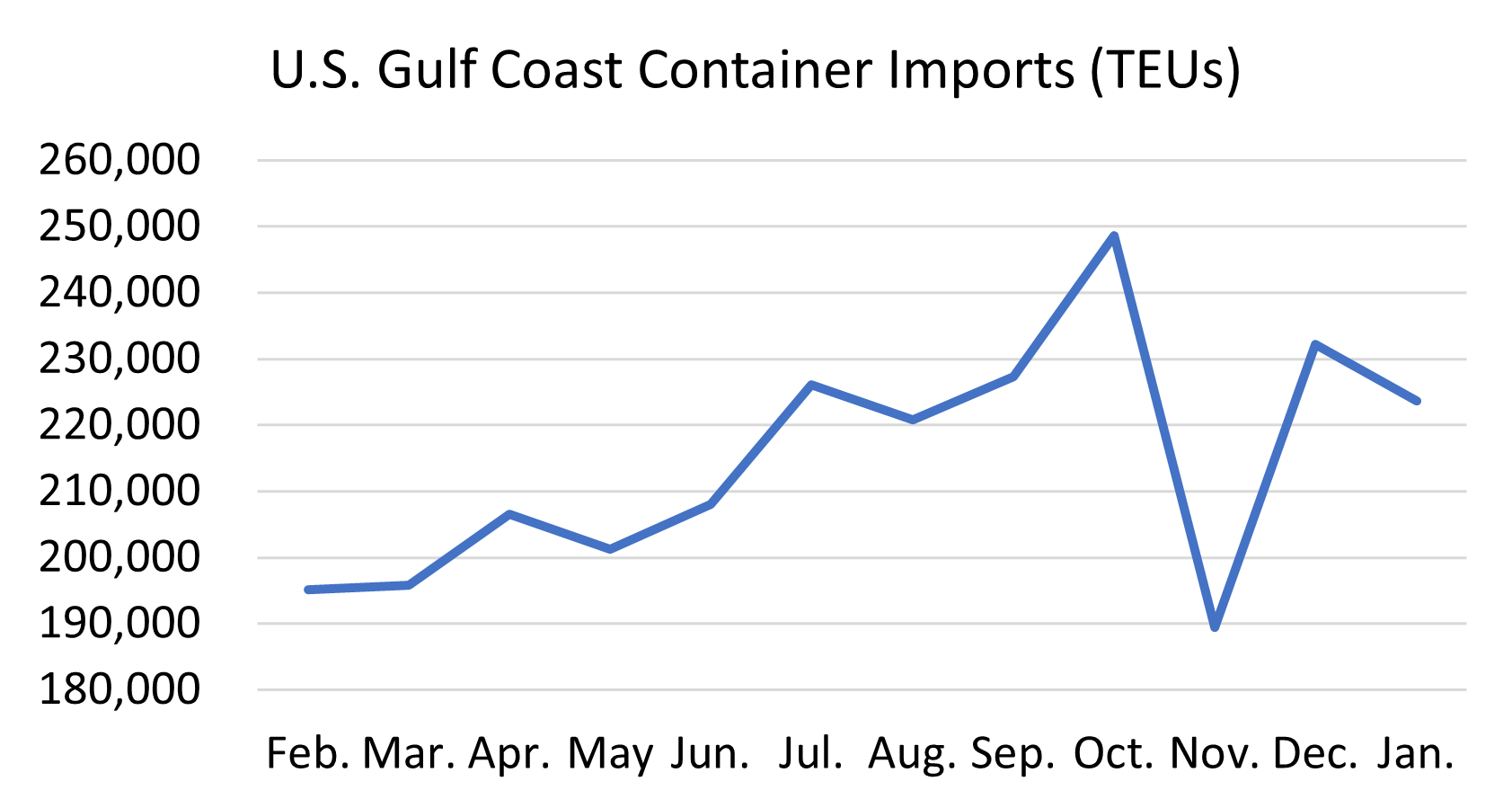
Source: Descartes Datamyne™
To access other articles that track port congestion monthly, visit the
Global Shipping Resource Center
White Papers
Survey Uncovers Supply Chain Strategies of Top Performing Companies
Surviving Peak Season and Beyond: The Essential Guide to Supply Chain Resiliency

Executive Vice President of Industry and Services
Descartes Systems Group
The Must-Read Guide on U.S. Maritime Ports

See the impact port congestion has had on U.S. imports, and gain insights into how to mitigate risks in your supply chain.
Stay Informed. Download the Report.
Potential labor disruption at South Atlantic and Gulf Coast ports in 2024.
The agreement between the International Longshoremen’s Association (ILA) and United States Maritime Alliance (USMX) is set to expire at the end of September 2024. A labor action would disrupt operations at South Atlantic and Gulf Coast ports. ILA leadership has stated that it will not extend the current agreement and told members to prepare for the possibility of a coast-wide strike in October 2024. Currently, there are still no statements of progress from either organization.
Managing supply chain risk: what to watch in 2024.
U.S. container import volume increased significantly in January 2024 and continued to surpass 2019 numbers. The economy is still exceeding expectations, which indicates healthy import volumes. However, challenges with the Panama drought, Middle East conflict and pending ILA contract negotiations point to further trade flow disruptions. Here’s what Descartes will be watching in 2024 to see if global supply chain performance will continue to improve:
- Monthly TEU volumes between 2.4M and 2.6M. This level will continue to stress ports and inland logistics until infrastructure can be enhanced. January U.S. container import volumes remained near 2.3M TEUs, which puts less pressure on ports.
- Port transit wait times. If they decrease, it’s an indication of improved global supply chain efficiencies capabilities or that the demand for goods and logistics services is declining. December port transit times increased on all coasts with East Coast ports experiencing the longest delays.
- Continuing impact of the pandemic. The spread of COVID subvariants continues to add uncertainty to the trajectory of the pandemic and impact supply chains in unpredictable ways as different countries are affected at different times and for different durations. Another new variant of COVID is causing infection rates to rise, which has not yet impacted supply chains and logistics resources but needs to be watched throughout the year.
- The economy. The U.S. is an import-driven economy, so economic health is an important indicator of container import volumes. However, there are many indicators that continue to provide conflicting stories. As of January 3, the Federal Reserve borrowing rate remained at 5.3% to slow inflation which was up slightly to 3.4% (as of January). The jobs growth numbers continue to exceed analysts’ expectations. Yet, consumers continue to spend as the inflation adjusted personal consumption expenditures of durable goods continues to rise with December 2023 figures (latest available) being the highest again in the last two years.
- Panama Canal-based trade flow. The combination of the drought impacting capacity and the recently ratified International Longshore and Warehouse Union (ILWU) could accelerate the redirection of the one million TEUs that shifted from the West Coast ports during the pandemic. Container volume in December at top East and Gulf Coast ports was up slightly, but East and Gulf Coast port transit times increased significantly which can also be attributed to the Middle East conflict (see immediately below).
- Middle East conflict. Attacks on shipping in the Red Sea by Houthis from Yemen could cause carriers to forego the Suez Canal, extending transit times and negatively impacting global shipping capacity. The impact of the diversion away from the conflict is starting to show up in the transit delay numbers for the East and Gulf Coast ports.
- ILA/USMX contract negotiation. A potential strike on the South Atlantic and Gulf Coasts could disrupt U.S. container imports later in 2024. Given the current Panama Canal situation, shifting volume to West Coast ports could be extremely challenging or significantly extend transit times. No progress was cited in January.
Consider recommendations to help minimize global shipping challenges.
January 2024 U.S. container import volumes were significantly higher compared to December 2023, and were ~10% higher than January 2022 or 2019 numbers. Overall port transit times in January were much higher than December numbers. Ongoing issues in Panama and the Middle East are creating pressure on global supply chains that could cause disruptions throughout 2024. Descartes will continue to highlight key Descartes Datamyne, U.S. government and industry data in the coming months to provide insight into global shipping. Recommendations remain unchanged from Descartes’ January Global Shipping Report.
Short-term:
- Track the spread of COVID variants to determine when they will hit critical parts of the supply chain, especially in China.
- Track ocean shipments and carrier performance as there is still a considerable gap between original ETAs and actual ones.
- Track the Panama Canal situation as the drought may impact shipping capacity and timeliness and even cause rerouting of supply chains.
- Track the Middle East conflict as carriers have begun to divert shipping around Africa, and this will impact shipping capacity and timeliness.
- Evaluate the impact of inflation and the Russia/Ukraine and Israel/Hamas conflicts on logistics costs and capacity constraints. Ensure that key trading partners are not on sanctions lists.
- Evaluate the potential impact of an ILA strike in October 2024 on South Atlantic and Gulf Coast ports to determine alternate ports or trade lanes.
Near-term:
- For companies importing from Asia, reevaluate trade that was moved away from West Coast ports.
- For companies that have cargo moving through the Suez Canal, evaluate the impact of extended rerouting.
Long-term:
- Evaluate supplier and factory location density to mitigate reliance on over-taxed trade lanes and regions of the globe that have the potential for conflict. Density creates economy of scale but also risk, and the pandemic and subsequent logistics capacity crisis highlights the downside. Conflicts do not happen “overnight” so now is the time to address this potentially business disrupting issue.
Note: This report uses the initial compiled release of U.S. Customs and Border Protection (CBP) data and is subject to revision later by CBP. The revised data can be seen in Descartes Datamyne.
How Descartes Can Help
Descartes Datamyne delivers business intelligence with comprehensive, accurate, up-to-date, import and export information.
Our multinational trade data assets can be used to trace global supply chains and our bill-of-lading trade data – with cross-references to company profiles and customs information – can help businesses identify and qualify new sources. Ask us for a free, no obligation demonstration of our data on a product or trade commodity of your choosing – and keep the custom research we create with our compliments.
